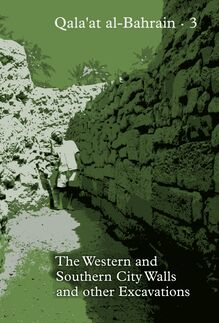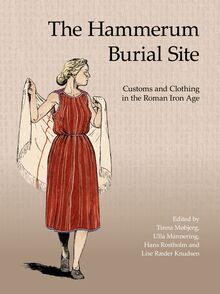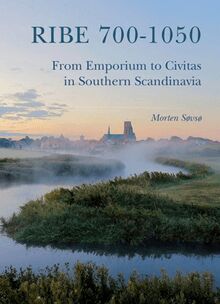Ribe 700-1050 , livre ebook
285
pages
English
Ebooks
2020
Obtenez un accès à la bibliothèque pour le consulter en ligne En savoir plus
Découvre YouScribe en t'inscrivant gratuitement
Découvre YouScribe en t'inscrivant gratuitement
285
pages
English
Ebooks
2020
Obtenez un accès à la bibliothèque pour le consulter en ligne En savoir plus
Publié par
Date de parution
17 décembre 2020
Nombre de lectures
1
EAN13
9788793423558
Langue
English
Poids de l'ouvrage
53 Mo
Ribe 700-1050: From Emporium to Civitas in Southern Scandinavia is volume 2 in Ribe Studies. The main text here provides a comprehensive presentation and analysis of the archaeology of the town through to the end of the Viking Period. Alongside that, the book has a major topographical section which discusses West Jutland in this period and the connexions between Ribe and the hinterland of the town. In addition, a concluding chapter discusses the origin of towns in southern Scandinavia.
Publié par
Date de parution
17 décembre 2020
Nombre de lectures
1
EAN13
9788793423558
Langue
English
Poids de l'ouvrage
53 Mo
Morten Søvsø
RIBE 700-1050
RIBE 700-1050
From Emporium to Civitas
in Southern Scandinavia
Morten Søvsø
Museum of Southwest Jutland
Jutland Archaeological Society
112260_cover_ribe-700-1050_ID20_.indd 1 23/11/2020 08.04Ribe 700-1050
From Emporium to Civitas in Southern Scandinavia
112260_ribe_.indd 1 23/11/2020 09.53To the generations of Ribe’s antiquaries
112260_ribe_.indd 2 23/11/2020 09.53Ribe 700-1050
From Emporium to Civitas
in Southern Scandinavia
Morten Søvsø
Museum of Southwest Jutland
Jutland Archaeological Society
112260_ribe_.indd 3 23/11/2020 09.53Ribe 700-1050: From Emporium to Civitas in Southern Scandinavia
RIBE STUDIER 2
© The author and Jutland Archaeological Society 2020
Layout and cover: Ea Rasmussen
Translation: John Hines
Graphics: Lars Foged Thomsen
Cover photo: Jens Karsten Jørgensen
E-book production by Narayana Press, Gylling
Type: ITC New Baskerville
Jutland Archaeological Society Publications 113
ISBN: 978-87-93423-55-8 (e-pdf)
ISSN: 0107-2854
Published in co-operation with
Museum of Southwest Jutland/Sydvestjyske Museer
Jutland Archaeological Society
Moesgård
DK-8270 Højbjerg
Distribution:
Aarhus University Press
Published with the support of:
Dronning Margrethe II’s Arkæologiske Fond
Aage og Johanne Louis-Hansens Fond
VELUX FONDEN
Slots- & Kulturstyrelsen
112260_ribe_.indd 4 23/11/2020 09.53Contents
Foreword 7
1 Introduction 9
2 Aspects of the theoretical discussion of towns and their origins in northern Europe 13
2 1 Starting point 13
2 2 What is a town? 15
2 3 Henri Pirenne and the trade model 18
2 4 Karl Polanyi and trade in the ‘pre-modern’ society 19
2 5 Dark Age Economics 19
2 6 The Viking Age in Denmark 20
2 7 The Medieval Town Project 21
2 8 From Tribe to State 21
2 9 The urban stage 22
2 10 A theory concerning the emporium of Ribe 22
3 History of research into Ribe 25
3 1 The Ribe Episcopal Chronicle 25
3 2 The renaissance historians: Hans Svaning, Anders Sørensen Vedel and Niels Krag 26
3 3 The ecclesiastical sphere: Peder Terpager and Matthias Galthen 27
3 4 The mapping of Ribe Town and Field 29
3 5 National romanticism and J Kinch’s Ribe Bys Historie og Beskrivelse 30
3 6 The main restoration of the cathedral and excavations in the churchyard in 1894 and 1930-1 36
3 7 Treasure fnds, 1874 onwards 37
3 8 The National Museum’s early excavations, 1911-41 37
3 9 Hugo Matthiessen’s Middelalderlige Byer 38
3 10 Mogens Bencard and the Grønnegade excavation of 1953-6 38
3 11 The rescue excavation at St Peder’s Church, 1960 41
3 12 The slip theory, 1962 42
3 13 New buildings in the town centre, 1959-78 43
3 14 The relocation hypothesis: Dankirke and Okholm, 1962-9 45
3 15 The original Ribe: excavations 1970-76 47
3 16 The Medieval Town Project and the dug-away hypothesis 49
3 17 Danmarks Kirker 51
3 18 Stig Jensen and Per Kristian Madsen 51
3 19 Excavations in the streets of the town from 1984 and the early damming hypothesis 52
112260_ribe_.indd 5 23/11/2020 10.533.20 The emporium of Ribe, 1984- 55
3.21 The urban archaeology meeting in Ribe, 1988- 59
3.22 The periodical By, marsk og geest, 1989- 59
3.23 Major excavations in the western suburbs of Ribe, 1987-2000 60
3.24 The use of metal-detectors and water-sieving in excavations in Ribe 63
3.25 Excavations at Ribe Cathedral, 2008-12 63
3.26 Summary: research history and the conceptual framework of town archaeology 65
4. Topography – the coastal zone of West Jutland in the Iron Age,
the Viking Period and the Middle Ages ..................................... 69
4.1 Introduction 69
4.2 The landscape of West Jutland in the Iron Age, the Viking Period and the Middle Ages 73
4.3 Landscape and people 83
4.4 Summary, Topography 123
5. Ribe AD 700-1050. . . . . . . . . . . . . . . . . . . . . . . . . . . . . . . . . . . . . . . . . . . . . . . . . . . . . . 129
5.1 The meaning of the place-name Ribe 129
5.2 The taphonomy of Ribe 129
5.3 The topography and hydrography of the area around the town 133
5.4 Earlier activity below the area of the town 143
5.5 Methods of excavation and recording 145
5.6 Chronological schemes 148
5.7 The principles for the presentation of archaeological evidence: inclusion and exclusion 149
5.8 Ribe in the 8th century 150
5.9 Ribe in the 9th century 173
5.10 Ribe in the 10th century 204
5.11 Ribe in the 11th century 215
5.12 Summary: Ribe AD 700-1050 224
6. The urbanization of southern Scandinavia, AD 700-1050 ...................... 225
6.1 The frst emporia 225
6.2 Danish emporia in the 9th and 10th centuries 232
6.3 Towns as centres of the Christian kingship from around the year 1000: the civitas model 243
6.4 Conclusion: From emporium to civitas in Southern Scandinavia 253
7. Summary ............................................................. 257
Ribe AD 700-1050 – from Emporium to Civitas in southern Scandinavia 257
Why and how did Ribe begin to exist? 258
How did Ribe evolve between AD 700 and 1050 – both in terms of topography and economy? 258
Is the model of Ribe’s development applicable to other early towns in southern Scandinavia? 259
8. Bibliography .......................................................... 261
Notes .................................................................. 277
Appendix: Dendrochronology in Ribe until 2015 .............................. 279
Appendix: Plate 1 ........................................................ 285
112260_ribe_.indd 6 23/11/2020 09.53Foreword
In 2006, Claus Feveile published Det ældste Ribe [The My hope is that this book about Ribe in the period
earliest Ribe], launching the publication series Ribe AD 700-1050 will be able to explain exactly why Ribe
Studier [Ribe Studies]. The goal of that series was to is a unique site, and also why the study of the early
make the core archaeological evidence from excava- towns is able not only to provide information about
tions in the town of Ribe between 1984 and 2000 ac- trading patterns but can be part of more general
cessible to the scholarly world and to give an account discussions concerning power and economy in those
of Ribe’s special status in the archaeological landscape areas of land which were subsequently to become
of Denmark and northern Europe. known as Denmark.
The present book, Ribe 700-1050: From Emporium A supplementary aspiration, however, is that this
to Civitas in Southern Scandinavia, is volume 2 in Ribe book will succeed in crossing contemporary national
Studies. The main text here provides a comprehen- borders, which impose constraints when one is
ensive presentation and analysis of the archaeology of gaged in research upon the Viking Age and the
widethe town through to the end of the Viking Period. ranging seaborne mobility that was characteristic of
Alongside that, the book has a major topographical and defnes that period.
section which discusses West Jutland in this period and The text was written in the period 2013-17 and has
the connexions between Ribe and the hinterland of been updated down to the year 2020. The principal
the town. In addition, a concluding chapter discusses emphasis has been laid upon the archaeological
feathe origin of towns in southern Scandinavia. tures, rather than upon the artefactual fnds. That
As will become clear in what follows, the earliest selection was necessary in consideration of the size
Ribe is a unique archaeological site within the borders of the volume, but it is possible to access the massive
of present-day Denmark — our only true emporium collection of fnds from Ribe in its entirety in digital
— and that this special status is both a blessing and form via the museum’s on-line collection, accessible
a challenge when one has the privilege of working at http://sol.sydvestjyskemuseer.dk
on the archaeology of the town. Research into Ribe continues, and in 2017-18 the
Archaeologists working here are used to deal- research excavation Northern Emporium funded
ing with thousands of fnds of glass beads, sherds by the Carlsberg Fund and under the leadership of
of glass vessels, moulds and Carolingian pottery; Professor Søren M. Sindbæk from the Centre for
fnds of a kind that are exceptionally rare elsewhere Urban Network Evolutions at Aarhus University took
in Denmark. How is this massive difference to be place. This exciting project has, amongst other things,
understood? produced crucial new evidence about the settlement
The whole situation is rendered no less complicated on the plots of the earliest Ribe. These results will be
by the fact that the closest parallels to Ribe are found published separately and have, except for note 20 on
in our two neighbouring countries: namely at Reric, page 156 and two sentences on page 169, not led to
close to the village of Gross Strömkendorf north of changes in the present text.
Wismar in Mecklenburg-Vorpommern, and Åhus at My heartfelt thanks to my colleagues in Sydvestjyske
the mouth of the Helge River in eastern Skåne. Ribe, Museer, whose support and constructive criticism
Reric and Åhus have inevitably been studied within has had nothing but a positive effect on the quality
the frameworks of the legal situation and the research of this book. Despite the fact that the museum in
traditions of three different nations, with all of the Ribe has grown in recent years it has been possible
barriers and differences that those will give rise to. to maintain the excellent working culture which was
7
This page is protected by copyright and may not be redistributed
112260_ribe_.indd 7 23/11/2020 09.53characteristic of Den antikvariske Samling in its day. of the manuscript. Translation, completion of illustr-a
This sense of responsibility for curating research into tions, and the printing of the book are entirely funded
Ribe and the history of the town is a constant factor b



